warning AUDI S4 2018 Owners Manual
[x] Cancel search | Manufacturer: AUDI, Model Year: 2018, Model line: S4, Model: AUDI S4 2018Pages: 403, PDF Size: 66.81 MB
Page 345 of 403
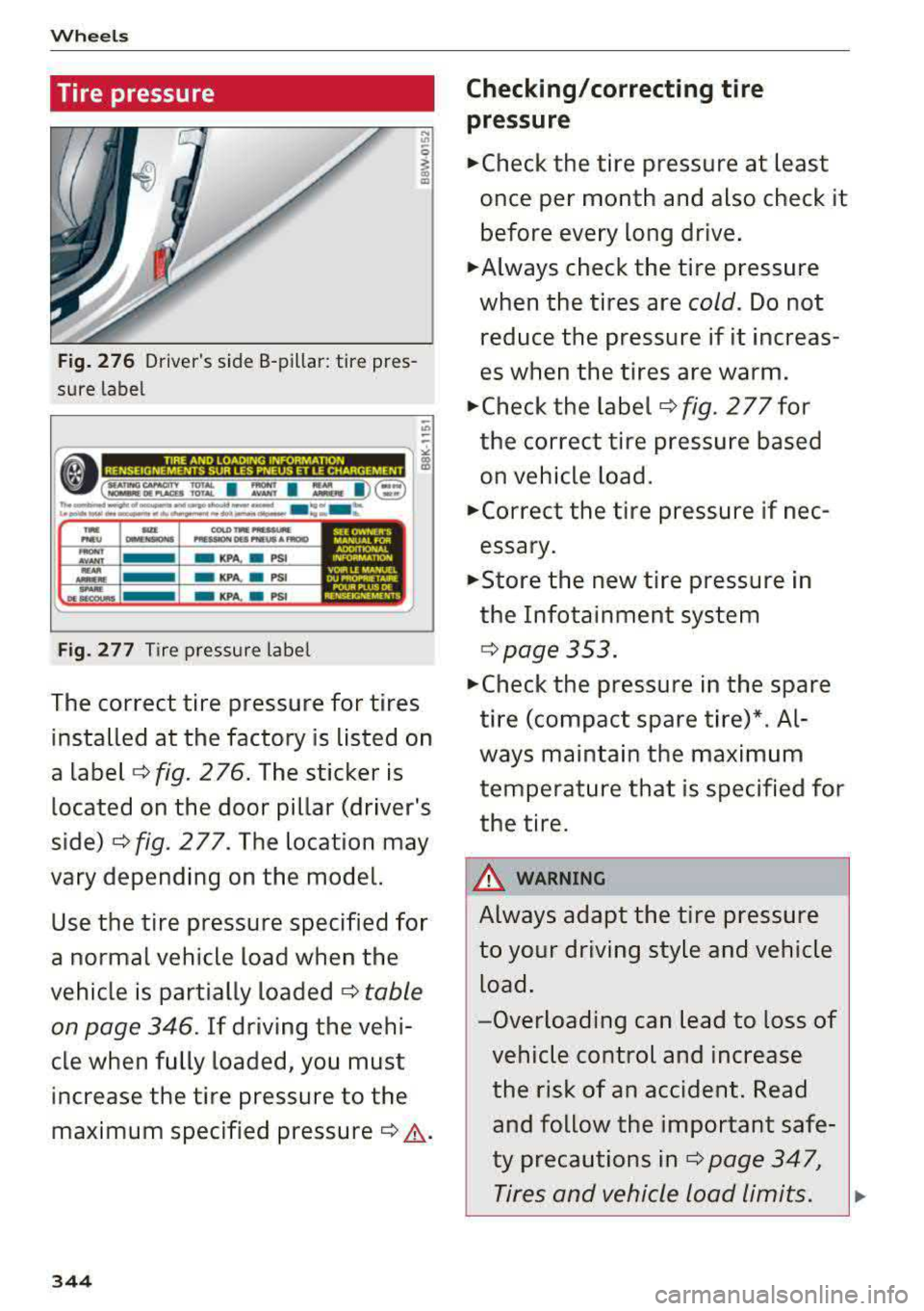
Wheels
Tire pressure
Fig. 276 Driver's side 8-pillar: tire pres
sure label
io
-
i' 9 ~ c=- =_ -_,_, -- --... - .- -- .- -- .-~ t='I
- - ----_ l i
_NOlall!:Ol,ua.s fOTAL AYA>lf .t.MICftf I/ ~ n,.....,...__ ........ .,._... ..... ._....,. . ... ... l ..................... ......,....,..,.......,.... ... -..
-KP a PSI
-KPA. a PSI J
l== ===·
=KP ='A.= ·=PSl = ~~~~
Fig. 277 Tir e pr essur e lab el
The correct tire pressure for tires
installed at the factory is listed on
a
label ¢ fig. 2 76. The sticker is
located on the door pillar (driver's
side)
¢ fig. 2 77. The location may
vary depending on the model.
Use the tire pressure specified for
a normal vehicle load when the
vehicle is partially
Loaded¢ table
on page 346.
If driving the vehi
cle when fully loaded, you must increase the tire pressure to the
maximum specified
pressure ¢ A-
344
Checking/correcting tire
pressure
,..Check the tire pressure at least
once per month and also check it
before every long drive .
.,..Always check the tire pressure
when the tires are
cold. Do not
reduce the pressure if it increas
es when the tires are warm.
.,.Check the Labe l ¢fig. 277for
the correct tire pressure based
on vehicle load.
.,..Correct the tire pressure if nec
essary .
.,..Store the new tire pressure in
the Infotainment system
¢ page 353 .
.,.Check the pressure in the spare
tire (compact spare tire)*. Al
ways maintain the maximum
temperature that is specified for
the tire.
A WARNING
Always adapt the t ire pressure
to your driving style and vehicle load.
-Overloading can lead to loss of vehicle control and increase
the risk of an accident. Read and follow the important safe
ty precautions in
¢ page 347,
Tires and vehicle load limits.
Page 348 of 403
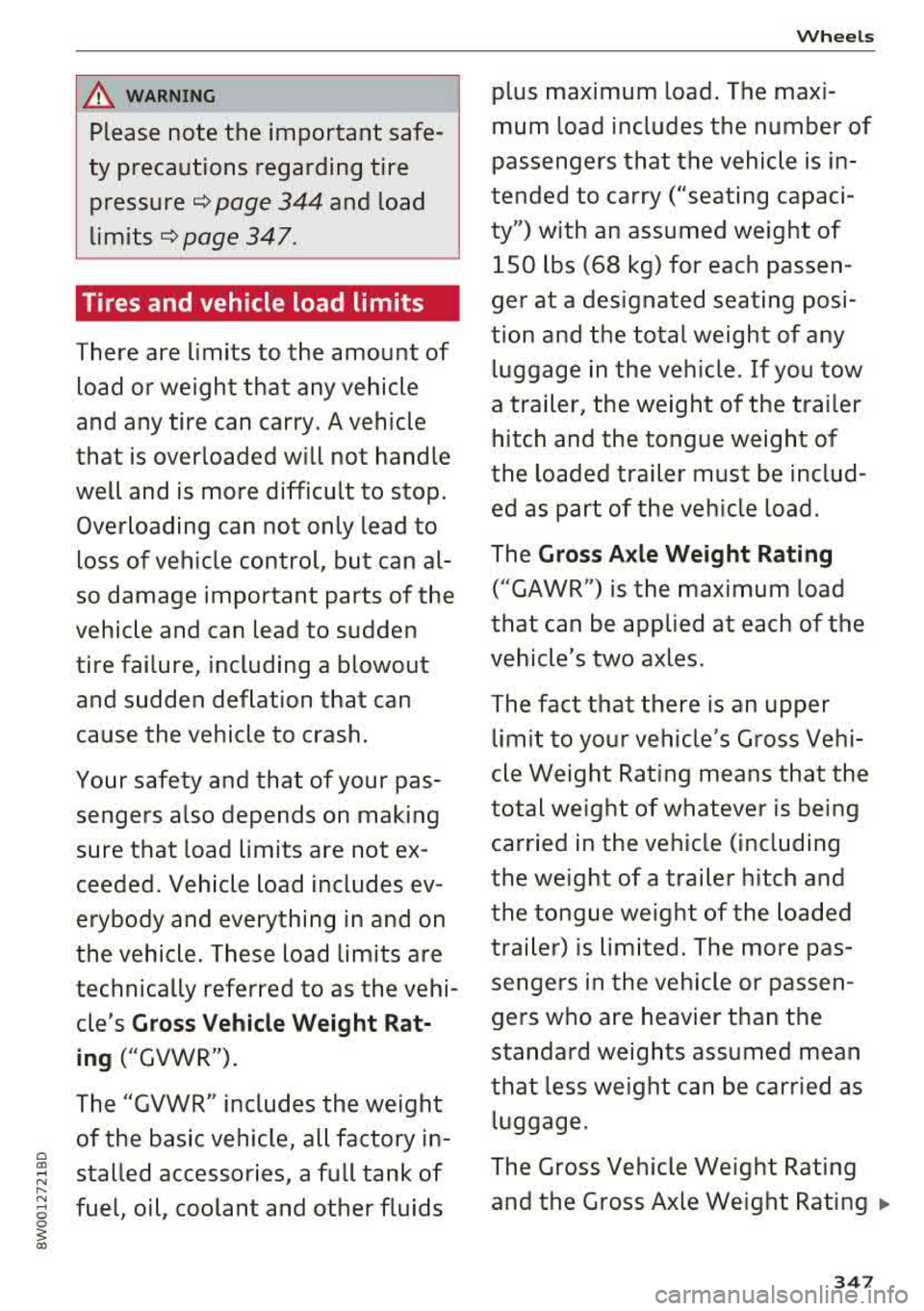
0 C0 .-< N ..... N .-< 0
~ a:,
.&_ WARNING
Please note the important safe
ty precautions regarding tire
pressure
¢ page 344 and load
limits
¢ page 347 .
Tires and vehicle load limits
There are limits to the amount of
load or weight that any vehicle
and any tire can carry. A vehicle
that is overloaded will not handle
well and is more difficult to stop.
Overloading can not only lead to
loss of vehicle control, but can al
so damage important parts of the
vehicle and can lead to sudden
tire failure, including a blowout and sudden deflation that can
cause the vehicle to crash.
Your safety and that of your pas sengers also depends on making
sure that load limits are not ex
ceeded. Vehicle load includes ev
erybody and everything in and on
the vehicle. These load limits are
technically referred to as the vehi cle's
Gross Vehicle Weight Rat
ing
("GVWR").
The "GVWR" includes the weight
of the basic vehicle, all factory in
stalled accessories , a full tank of
fuel, oil, coolant and other fluids
Wheels
plus maximum load. The maxi
mum load includes the number of
passengers that the vehicle is in
tended to carry ("seating capaci
ty") with an assumed weight of
150 lbs (68 kg) for each passen
ger at a designated seating posi
tion and the total weight of any
luggage in the vehicle. If you tow
a trailer, the weight of the trailer
hitch and the tongue weight of
the loaded trailer must be includ ed as part of the vehicle load .
The
Gross Axle Weight Rating
( " GAWR ") is the maximum load
that can be applied at each of the
vehicle's two axles.
The fact that there is an upper
limit to your vehicle 's Gross Vehi
cle Weight Rating means that the
total weight of whatever is being
carried in the vehicle (including
the weight of a trailer hitch and
the tongue weight of the loaded
trailer) is limited. The more pas
sengers in the vehicle or passen
gers who are heavier than the
standard weights assumed mean
that less weight can be carried as luggage.
The Gross Vehicle Weight Rating and the Gross Axle Weight Rating
.,.
347
Page 349 of 403
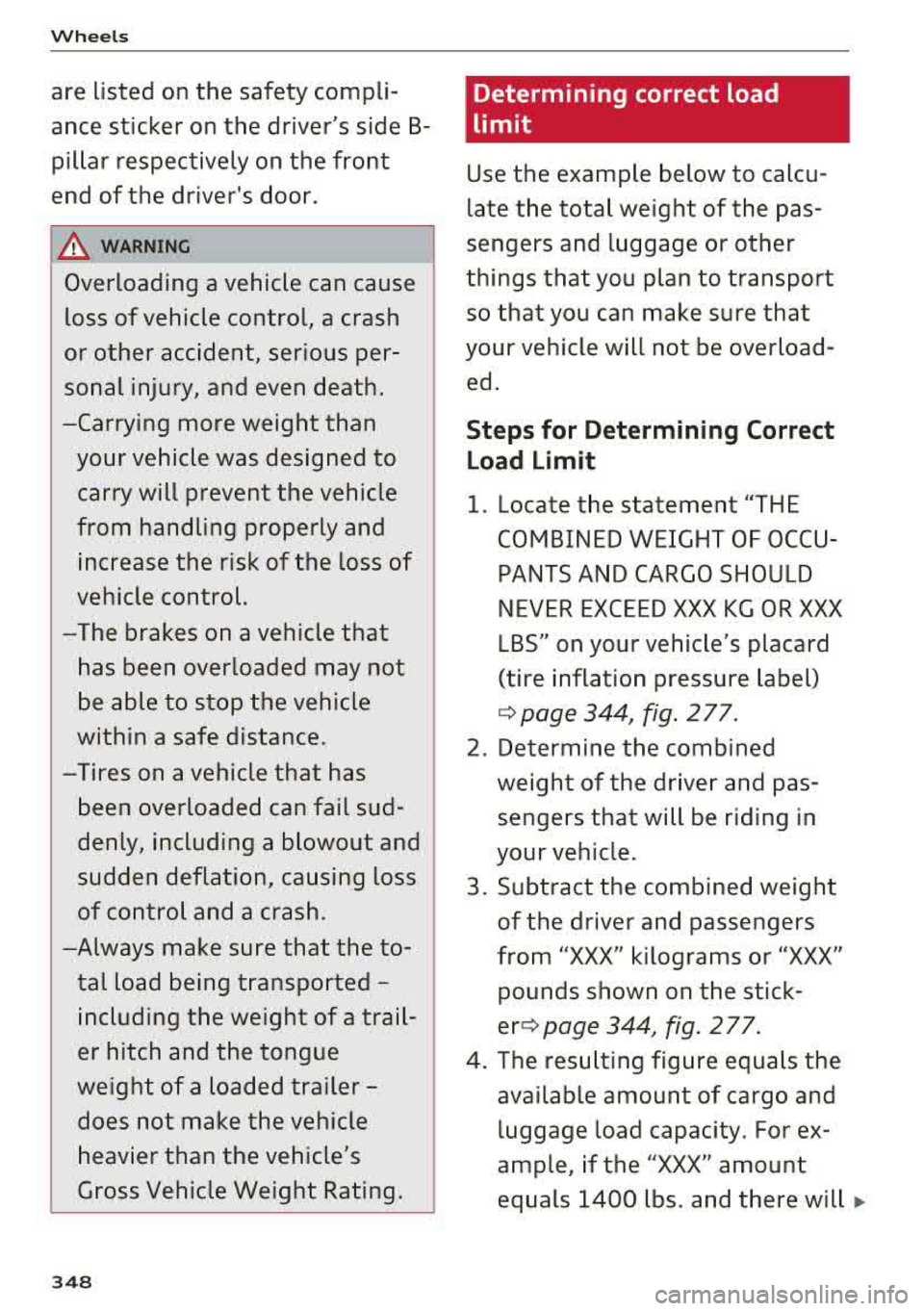
Wheels
are listed on the safety compli
ance sticker on the driver's side B pillar respectively on the front
end of the driver's door.
& WARNING
-
Overloading a vehicle can cause
loss of vehicle control, a crash
or other accident, serious per
sonal injury, and even death.
-Carrying more weight than your vehicle was designed to carry will prevent the vehicle
from handling properly and increase the risk of the loss of
vehicle control.
-The brakes on a vehicle that
has been overloaded may not
be able to stop the vehicle
within a safe distance .
-Tires on a vehicle that has been overloaded can fail sud
denly, including a blowout and
sudden deflation, causing loss of control and a crash .
-Always make sure that the to tal load being transported -
including the weight of a trail
er hitch and the tongue
weight of a loaded trailer -
does not make the vehicle
heavier than the vehicle's
Gross Vehicle Weight Rating.
348
Determining correct load
limit
Use the example below to calcu
late the total weight of the pas
sengers and luggage or other
things that you plan to transport so that you can make sure that
your vehicle will not be overload
ed.
Steps for Determining Correct Load Limit
1. Locate the statement "THE
COMBINED WEIGHT OF OCCU
PANTS AND CARGO SHOULD
NEVER EXCEED XXX KG OR XXX
LBS" on your vehicle's placard
(tire inflation pressure label)
¢ page 344, fig. 277.
2. Determine the combined
weight of the driver and pas sengers that will be riding in
your vehicle.
3. Subtract the combined weight
of the driver and passengers
from
"XXX" kilograms or "XXX"
pounds shown on the stick
er ¢ page 344, fig. 2 77.
4. The resulting figure equals the
available amount of cargo and luggage load capacity . For ex
ample, if the "XXX" amount
equals 1400 lbs. and there will
.,.
Page 350 of 403
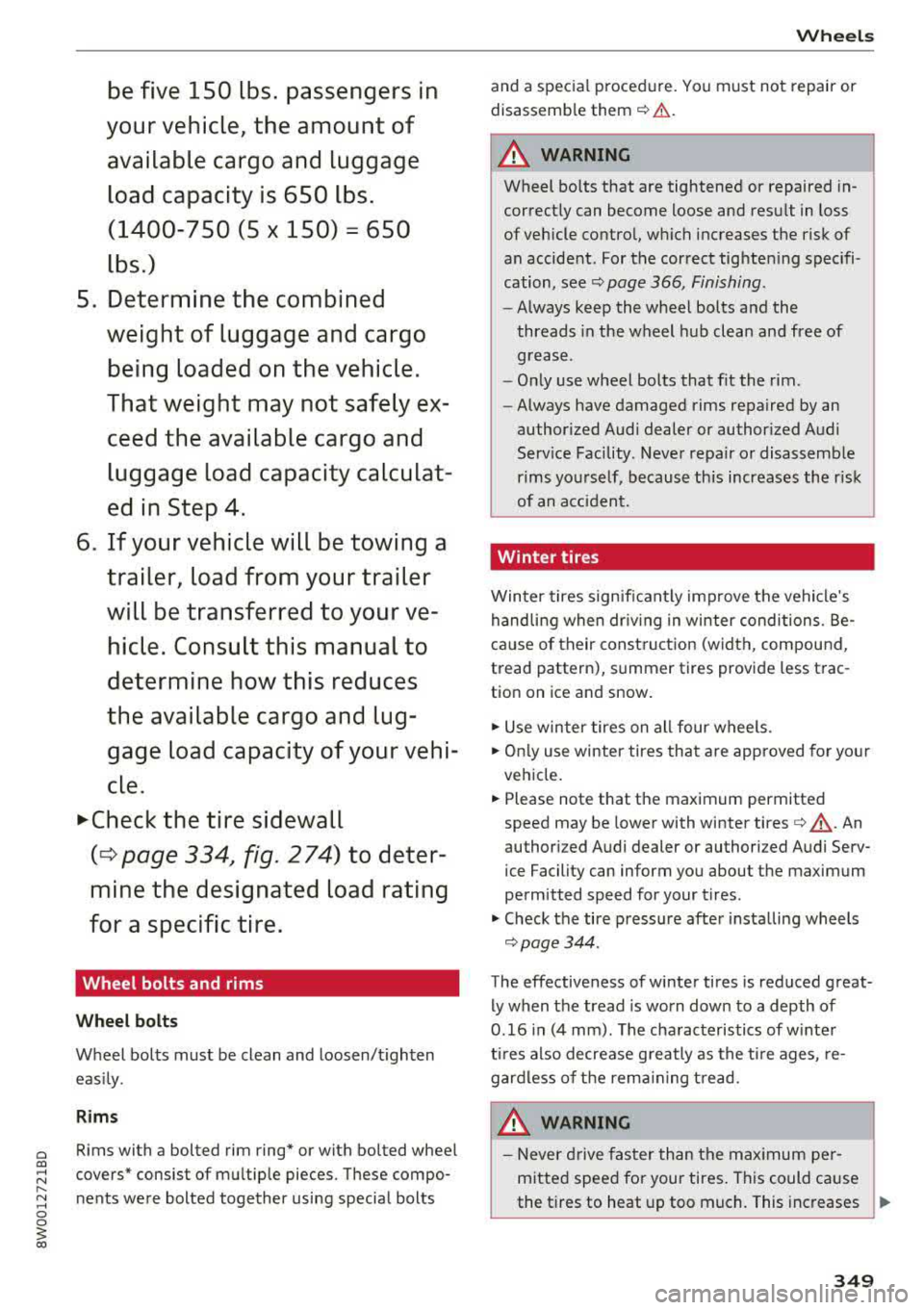
a co .... N ,....
N .... 0 0
3 co
be f ive 150 lb s. pa ssenge rs in
yo ur ve hicle, th e amo unt of
ava ila bl e c argo a nd lu ggag e
l oa d cap acity is 650 lb s.
(1400-750 (5 X 150) = 650
lb s.)
5 . Determin e th e co mbined
we ig ht of lu ggag e and cargo
bein g load ed on the ve hicle .
Th at w eight may not sa fely ex
c e e d th e ava ilabl e ca rgo a nd
lugg age l oad ca paci ty ca lc ul at
e d in St ep 4 .
6 . If yo ur vehicle will b e to wing a
tr ailer, load from y our tr ailer
will b e tran sferr ed to y our v e
hi cle . C on sul t thi s manual t o
dete rmin e how this re duces
th e av ailabl e c argo and lug
ga ge load capac ity o f your vehi
c le.
..,.Ch eck the tire side wall
(c:> page 334, fi g . 2 7 4) to d eter
min e the de sign ated load r ating
for a sp ecifi c tire.
Wheel bolts and rims
Wheel bolts
Wheel bolts must be clean and loosen/t ighten
eas ily .
Rims
Rims with a bolted rim ring* or with bolted wheel
covers* consist of mu ltip le pieces. These compo
nents were bolted together using special bolts
Wh eel s
and a special procedu re. Yo u must not repair or
disassemb le them
~ &. .
A WARNING
-Wheel bo lts that are tightened or repaired in-
correct ly can become loose and resu lt in loss
of vehicle contro l, wh ich increases the risk of
an accident. For the cor rect tighten ing specifi
cation,
see¢ page 366, Finishing .
-Always keep the wheel bolts and the
threads in the wheel hub clean and free of
g rease .
- Only use wheel bolts that fit the rim.
- Always have damaged rims repaired by an
author ized Audi dealer or author ized Audi
Serv ice Facility . Never repair or disassemb le
rims yourself, because th is increases the r isk
of an a cc ident.
Winter tires
Winter tires signific ant ly imp rove the vehicle 's
handling when dr iv ing in winter conditions . B e
ca use of their construct ion (w idth, compound,
tread pattern), summer tires provide less t rac
tion on ice and snow .
.,. Use winter tires on all four wheels.
.,. Only use winter tires that are approved for your
vehicle.
.,. Please note that the maximum permitted
speed may be lower with winter
tires ¢,& . An
author ized Audi dealer or authorized Audi Serv
ice Facility can inform you about the maximum permitted speed for your tires .
.,. Check the tire pressure after installing wheels
~page 344 .
The effectiveness of winter tires is reduced great
ly when the tread is wo rn down to a depth of
0.16 in (4 mm). The cha racteristics of w inte r
ti res a lso decrease g reatly as the ti re ages, re
gardless of the rema in ing t read.
A WARNING
-
- Never drive fas ter than the max imum per
mitted speed for your tires . This could cause
the tires to heat up too much. This increases
..,.
349
Page 351 of 403
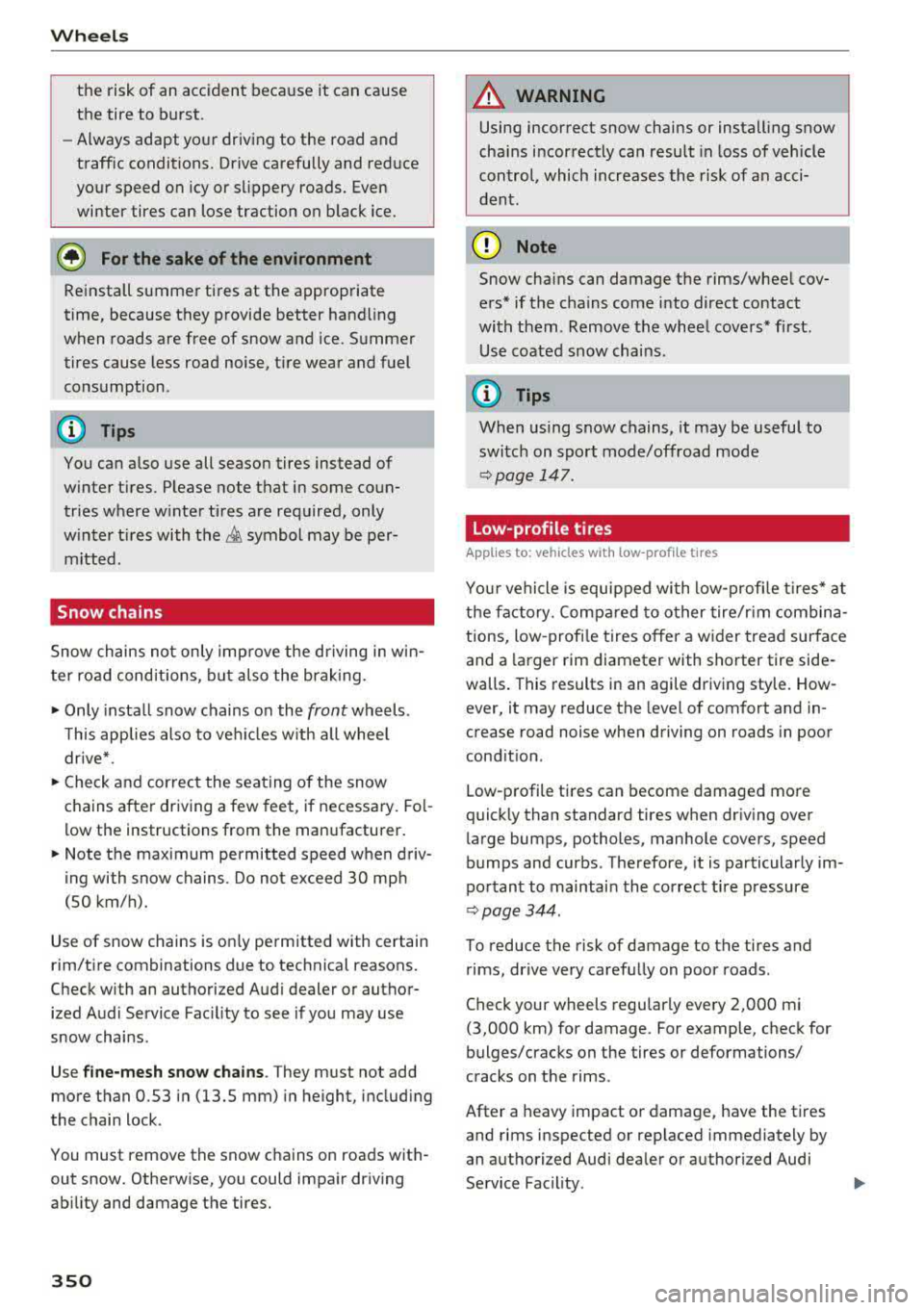
Wheels
the risk of a n acc ident beca use it can cause
the tire to burst.
- Always adapt your driving to the road and
traff ic conditions. Drive carefully and red uce
yo ur speed on icy or slippery roads. Even
winter tires can lose traction on b lack ice.
@ For the sake of the environment
Reinstall summe r tires at the approp riate
time, because they provide better hand ling
when roads are free of snow and ice. S ummer
tires cause less road noise, tire wear and fuel
consumption.
(D Tips
You can also use all season tires instead of
w inter t ires. Please note that in some coun
tries w here w inte r ti res are req uired, only
w inter t ires with the
& symbol may be per
m itted.
Snow chains
Snow ch ains not only i mprove the d riving in win
t er ro ad cond itions, b ut also the brak ing.
... Only insta ll snow chains o n the front wheels .
T h is applies also to ve hicles w ith all wheel
drive* .
... Check an d cor rect the sea ting of the snow
c h ains a fte r dr iv ing a few feet, i f necessary. Fo l
l ow the instructions from the manufacturer .
... Note the maximum permitted speed when d riv
ing with snow chains . Do not exceed 30 mp h
(SO km/h).
Use of snow chains is on ly pe rmitted with certain
rim/t ire combinations due to technical reasons.
Check with an authorized Audi dealer o r autho r
ized Aud i Service Fac ility to see if yo u may use
snow chains.
Use
fine -mesh snow chains . They must not add
more t han 0.53 in (13.5 mm) in height, includ ing
the chain lock .
You must remove the snow c hains on roads wit h
out snow. Othe rw ise, you could impa ir dr iv ing
ab ility and damage the tires.
350
A WARNING ~
Using incorrect snow chains or installing snow
cha ins i ncor rectly can result in loss of veh icle
con trol, which increases the risk of a n acci
d ent.
(D Note
Snow chains can damage the rims/whee l cov
e rs* if the chains come into direct contact
wi th them . Remove the whee l covers* first.
Us e coated snow chai ns.
(D Tips
When using snow chains, it may be useful to
swi tc h on spo rt mode/offroad mode
<:;> pag e 147.
Low-profile tires
Applies to: vehicles with low-profile tires
Your vehicle is equip ped wi th low -profi le t ires* at
t h e factory. Compa re d t o o ther tire/r im com bina
tions, low -profi le tires offer a w ider tread surface
and a larger rim diameter with shorter tire side
walls . This results in an agile dr iv ing style. How
ever, it may reduce the leve l of com fort and in
crease road noise whe n driving on roads in poor
cond it ion.
Low-p rofile ti res can become damaged mo re
q uick ly than standard tires when dr iv ing ove r
l a rge bumps, potholes, manhole covers, speed
bumps and curbs . Therefore, it is particularly im
po rtan t to maintain the correct tire pressure
<:;> page 344.
To reduce the risk of damage to the tires and
rims, drive very caref ully on poor roads.
Check your wheels regu larly eve ry 2,000 mi
(3,000 km) for damage. For example, check for
bulges/cracks on the tires or deformations/
cracks on the rims .
After a heavy impact o r damage, have the tires
and rims inspected or replaced immediately by
an authorized Audi dea ler or authorized Audi
Service Facility .
Page 352 of 403
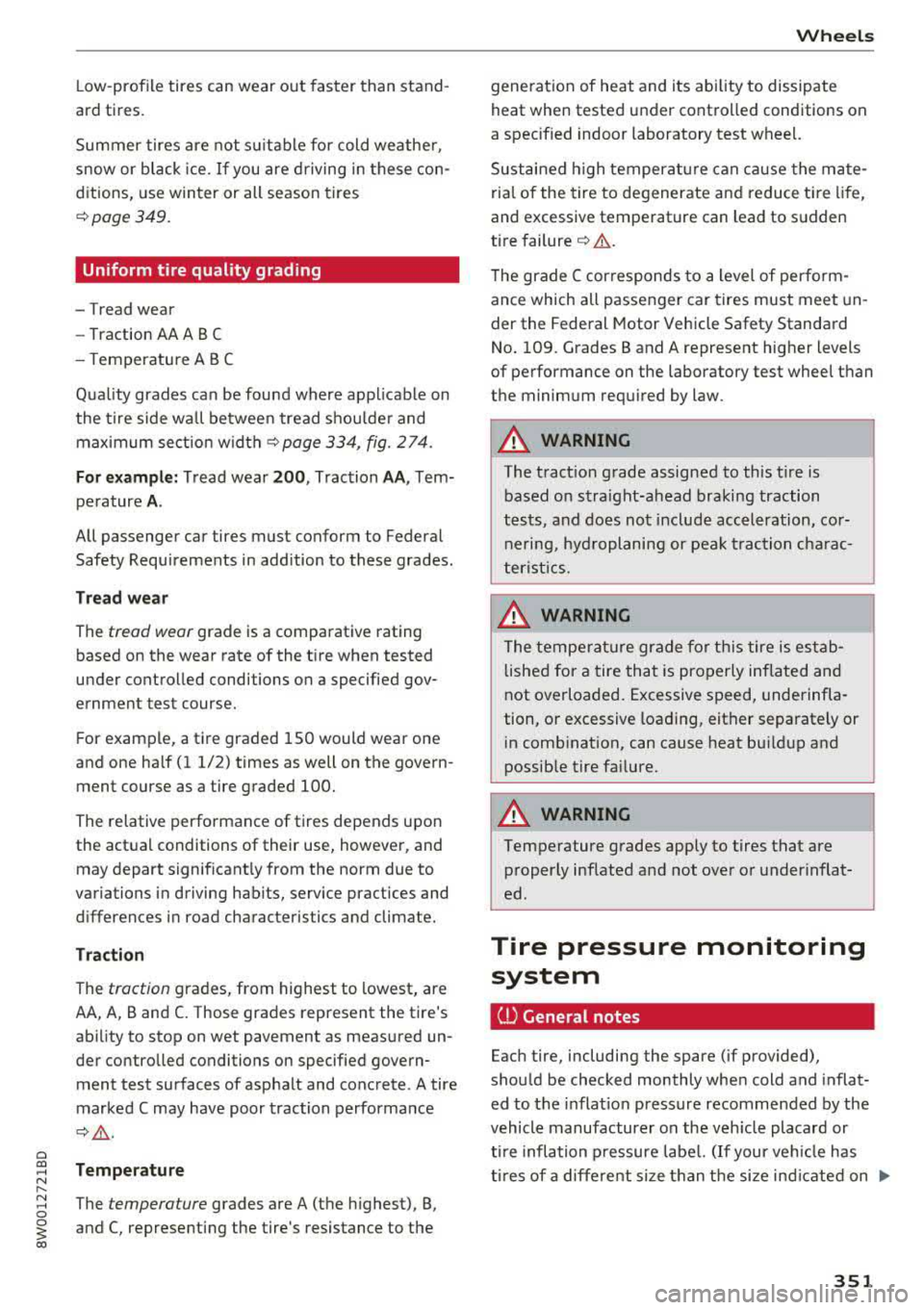
a co .... N ,....
N .... 0 0
3 co
Low -profile tires can wear out faster than stand
ard tires.
Summer tires are not su itable for cold weather,
snow or b lack ice. If you are driving in these con
ditions, use winter or all season tires
¢ page 349.
Uniform tire quality grading
-Tread wear
- Traction AA AB C
- T emperature ABC
Qual ity grades can be found where app licable on
the t ire side wa ll between tread shou lde r and
maximum sect ion w idth
¢page 334, fig. 274.
For e xample : Tread wear 200 , Traction AA, Tem
pe rature
A .
All passenger car tires must conform to Federal
Safety Requirements in addition to these grades.
Tread w ear
The tread wear grade is a comparative rating
based on the wear rate of the tire when tested
under controlled conditions on a specified gov
ernment test course.
F or example, a tire graded 150 would wear one
and one ha lf
(1 1/2) times as well on the govern
ment course as a tire graded 100.
The relative performance of tires depends upon
the actual conditions of their use, however, and
may depart significant ly from the norm due to
variations in driving hab its, service practices and
d ifferences i n road characteristics and climate.
Tracti on
The traction grades, from highest to lowest, are
AA, A, Band
C. Those grades represent the tire's
ab ility to stop on wet pavement as measured un
der controlled conditions on specified govern
ment test surfaces of asphalt and concrete . A tire
marked C may have poor traction performance
¢ _& .
Temper ature
The temperature grades are A (the h ighest), B,
and C, representing the tire's resistance to the
Wh eel s
generat ion of heat and its ability to dissipate
heat when tested under controlled conditions on
a specified indoor laboratory test wheel.
Sustained h igh temperature can cause the mate
ria l of the tire to degenerate and reduce tire life,
and excessive temperature can lead to sudden
tire
failure ¢.& .
The grade C corresponds to a level of per form
ance which all passenger car tires must meet un
der the Federal Motor Vehicle Safety Standard
No. 109. Grades Band A represe nt higher levels
of performance on the laboratory test wheel than
the minimum requ ired by law.
A WARNING c,...._ -
The tract ion grade assigned to this t ire is
based on straight-ahead braking traction
tests, and does not include acceleration, co r
nering, hyd roplaning or pea k traction cha rac
terist ics.
A WARNING
The temperature grade for this tire is estab
lished for a tire that is properly inflated and
not overloaded . Excessive speed, underinfla
tion, or excessive loading, either separately or
i n comb inat ion, can cause heat bu ildup and
possib le tire fai lure.
A WARNING
-Temperature grades apply to tires that are
properly inflated and not over or under inflat
ed.
Tire pressure monitoring system
ill General notes
Each tire, including the spare (if provided),
.
should be checked monthly when cold and inflat-
ed to the i nflat io n pressure recommended by the
vehicle manufacturer on the veh icle placard or
t ir e infla tion p ressure labe l. (If your ve hicle has
ti res of a different size t han t he si ze ind icated on
IIJi,-
351
Page 354 of 403
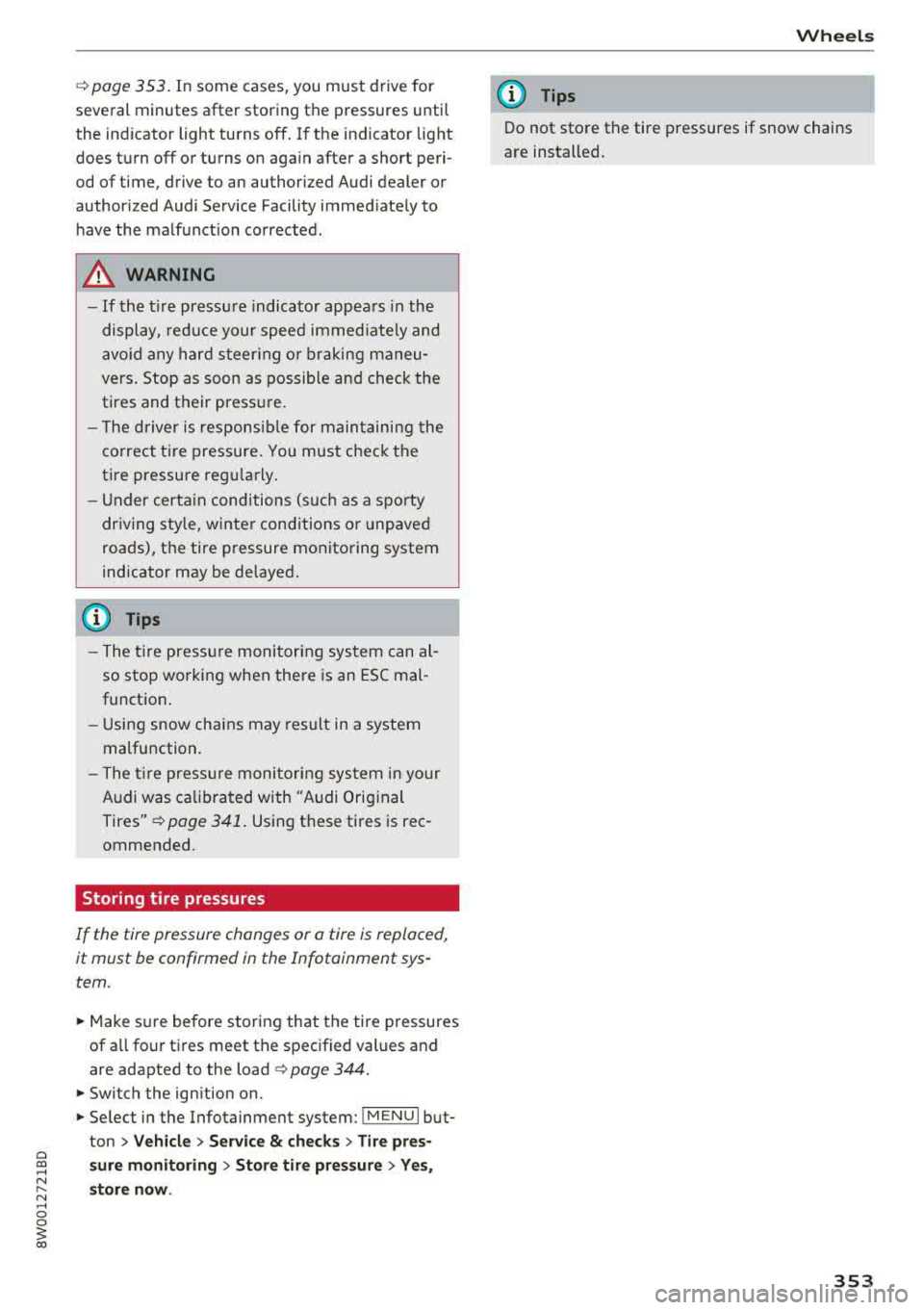
a co .... N ,....
N .... 0 0
3 co
q page 353. In some cases, you must drive for
several minutes after storing the pressures until
the indicator light turns off . If the indicator lig ht
does turn off or turns on aga in after a short peri
od of time, drive to an authorized Audi dealer or
author ized Audi Service Facility immed iately to
have the ma lfunction corrected .
A WARNING
-If the t ire pressu re indica tor appea rs in the
display, red uce your speed immed iate ly and
avoid any har d st eer ing or braking maneu
vers. Stop a s soon as possib le and check the
ti res and their press ure.
- T he driver is responsi ble for main taining the
cor rect ti re pressure. You must check the
tire pressure regu larly .
- Under certa in conditions (s uch as a sporty
driving style, winte r cond itio ns or unpaved
roads), the tire pressure monitoring system
indicator may be delayed.
(D Tips
- The t ire press ure monitoring sys tem can al
so stop work ing when there is an ESC mal
funct ion .
- Usin g snow chains may result in a system
malfunction.
- The t ire press ure moni toring sys tem in yo ur
A udi was ca librated with "A udi Orig inal
Tires"¢
page 341 . Using these ti res is rec
ommended.
Storing tire pressures
If the tire pressure changes or a tire is replaced,
it must be confirmed in the Infotainment sys tem.
~ Make s ure before storing that the tire pressures
of a ll fo ur ti res meet the specified values and
are adapted to the load
¢ page 344.
~ Switch the ign ition on.
~ Select in the Infotainment system: I MENUI but
ton
> Vehicle > Service & checks > Tire pre s
s ure monitoring > Store tire pres sure > Yes ,
store now .
Wheel s
{!) Tips
Do not store the tire pressures if snow chains
are installed.
353
Page 355 of 403

Care and cleaning
Care and cleaning
General information
Regular, proper care helps to maintain your vehi
cle's value.
It can also be a requirement when
submitting warranty claims for corrosion damage
and paint defects on the body.
The required cleaning and care products can be
obtained from an authorized Audi dealer or au
thorized Service Facility. Read and follow the in
structions for use on the packaging .
A WARNING
-Using cleaning and care products incorrectly
can be dangerous to your health .
- Always store cleaning and care products out
of reach of children to reduce the risk of poi
soning .
@ For the sake of the environment
- Preferably purchase environmentally-friend
ly cleaning products.
- Do not dispose of leftover cleaning and care
products with household trash.
Car washes
The longer that deposits such as insects, bird
droppings, tree sap or road salt remain on the ve hicle, the more the surface can be damaged. High
temperatures such as those caused by sunlight
increase the damaging effect .
Before washing, rinse off heavy deposits with
plenty of water.
Stubborn deposits such as bird droppings or tree
sap are best removed with plenty of water and a microfiber cloth.
Also, wash the underside of your vehicle once road salt stops being used for the season .
Pressure washers
When washing your veh icle w ith a pressure wash
er, always follow the operating instructions pro
vided with the pressure washer. This is especially
important in regard to the pressure and spraying
distance. Do not aim the spray directly at the
354
seals on the side windows, doors, lids or the sun
roof* or at tires, rubber hoses, insulating materi
al, sensors* or camera lenses* . Keep a distance of
at least 16 in (40 cm).
Do not remove snow and ice with a pressure
washer.
Never use cone nozzles or high pressure nozzles.
The water temperature must not be above 140 °F
(60 °().
Automatic car washes
Spray off the vehicle before washing.
Make sure that the windows and roof* are closed
and the windshield wipers are off . Follow instruc
tions from the car wash operator, especially if
there are accessories attached to your vehicle.
If possible, use car washes that do not have
brushes.
Washing by hand
Clean the vehicle starting from the top and work
ing down using a soft sponge or cleaning brush.
Use solvent-free cleaning products.
Washing vehicles with matte finish paint by
hand
To avoid damaging the paint when washing, first
remove dust and large particles from your vehi
cle. Insects, grease spots and fingerprints are
best removed with a special cleaner for matte
finish paint .
Apply the product using a microfiber cloth. To
avoid damaging the paint surface, do not use too
much pressure.
Rinse the vehicle thoroughly with water. Then
clean using a neutral shampoo and a soft micro
fiber cloth .
Rinse the vehicle thoroughly again and let it air
dry. Remove any water residue using a chamois .
A WARNING
-
- Only wash the vehicle when the ignition is
off and follow the instructions from the car
Page 358 of 403
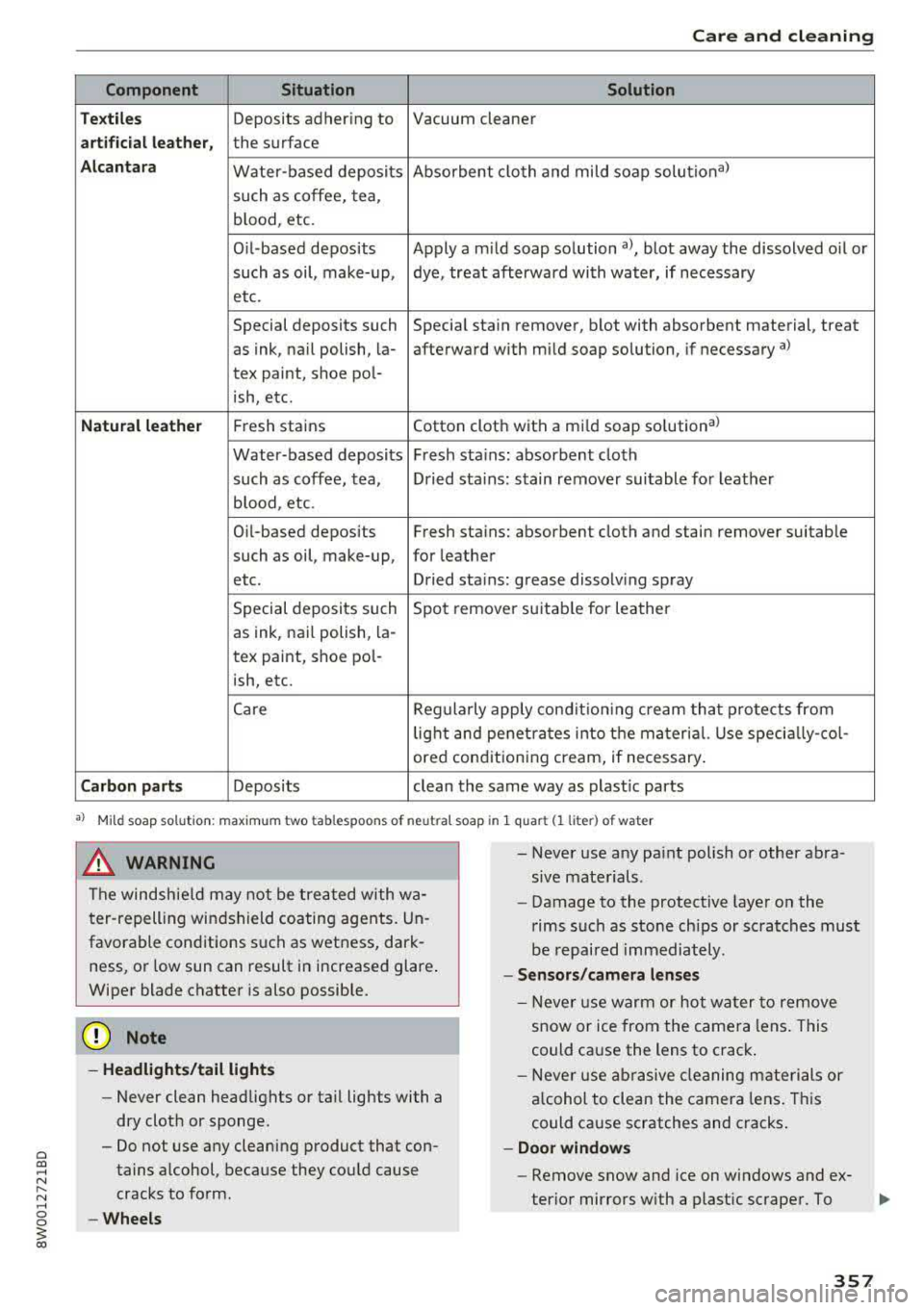
a co .... N ,....
N .... 0 0
3 co
Care and cleaning
Component Situation Solution
T ex til es
Deposits adhering to Vacuum cleaner
art ifici al leat her, the surface
A lcan tara Water-based deposits Absorbent
cloth and mild soap solutiona>
such as coffee, tea,
b lood, etc.
Oil -based deposits Apply a m ild soap solution
a), blot away the dissolved o il or
such as oil, make-up, dye, treat afterward with water, if necessary
etc.
Special deposits such
Special stain remover, blot with absorbent material, treat
as ink, nail polish, la- afterward with mild soap solution, if necessary
a)
tex paint, shoe pol-
ish, etc.
Natu ral le ath er Fresh stains Cotton cloth with a mild soap so lution a>
Water-based deposits Fresh stains: absorbent cloth
such as coffee, tea, Dried stains : stain
remover suitable fo r leather
b lood , etc.
Oi l-based deposits Fresh stains: absorbent cloth and stain
remover suitable
such as oil, make-up, for leather
etc. Dried stains : grease dissolving spray
Special deposits such Spot remove r suitab le for leather
as ink, nai l polish, la-
tex paint, shoe pol-
ish, etc.
Care Regularly apply condit ion ing c ream that protects from
lig ht and penet rates into the material. Use specia lly-co l-
ored conditioning cream, if necessary .
Carbon part s Deposits clean the same way as plast ic parts
a) Mi ld soap solution: maximum two tablespoons of neutral soap in 1 q uart (1 liter) of water
.8, WARNING
The windshield may not be trea ted with wa
ter-repelling windshield coating agents. Un
favorable cond itions such as wetness, dark
ness, or low sun can result in increased glare.
Wiper blade chatter is also possible.
@ Note
- Headlight s/tail li ght s
-Never clean headlights or tail lights with a
dry cloth or sponge.
- Do not use any cleaning product that con
tains alcohol, because they could cause
cracks to form.
- Whe els
-
- Never use a ny pa int polish or other abra
sive materials .
- Damage to the protect ive layer on the
rims such as sto ne ch ips or scratches must
be repaired immediately .
-Sen sor s/camera l enses
- Neve r use warm or hot water to remove
snow or ice from the camera lens . This
could cause the lens to crack .
- Neve r use ab rasive cleaning materials or
a lcohol to clean the camera lens . This
could cause scratches and cracks .
-Door window s
-Remove snow and ice on windows and ex-
terior mirrors w ith a plast ic scraper . To
357
Page 361 of 403
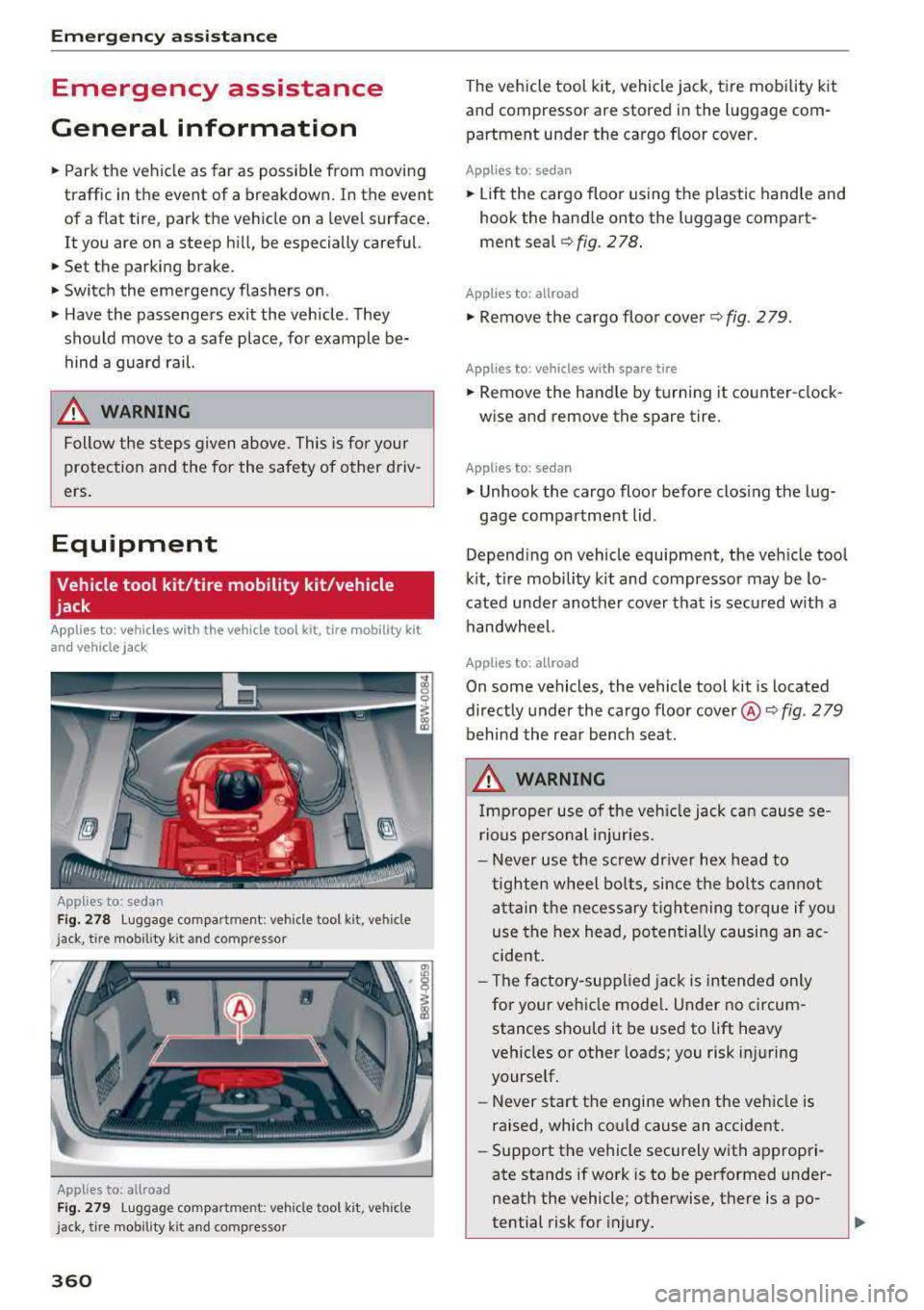
Emergency assistance
Emergency assistance
General information
... Park the vehicle as far as possible from moving
traffic in the event of a breakdown. In the event
of a flat tir e, park the vehicle on a level surface .
It you are on a steep hill, be especially careful.
.,. Set the parking brake .
.,. Switch the emergency flashers on .
... Have the passengers exit the vehicle . They
should move to a safe place, for example be
hind a guard rail.
_& WARNING
Follow the steps given above . This is for your
protection and the for the safety of other driv
ers.
Equipment
Vehicle tool kit/tire mobility kit/vehicle
jack
Applies to: vehicles with the vehicle tool kit, tire mobility kit
and veh icle jack
Applies to: sedan
Fig. 278 L uggage compartmen t: vehicle too l kit , ve hicle
j ack, tire mob ility kit an d comp resso r
Applies to: allroad
Fig. 279 Lug gage compa rtmen t: ve hicl e tool kit, v ehicle
j ack, tir e mobil ity k it and comp resso r
360
The vehicle tool kit, vehicle jack, tire mobility kit
and compressor are stored in the luggage com
partment under the cargo floor cover.
Applies to: sedan
.,. Lift the cargo floor using the plastic handle and
hook the hand le onto the luggage compart
ment
seal ~ fig. 2 78.
Applies to: allroad
... Remove the cargo floor cover ~ fig. 279 .
Applies to : vehicles with spare tire
... Remove the handle by turning it counter-clock
wise and remove the spare tire.
Appl ies to: sedan
.,. Unhook the cargo floor before closing the lug-
gage compartment lid .
Depend ing on vehicle equipment, the vehicle tool
kit, tire mobility kit and compressor may be lo
cated under another cover that is secured w ith a
handwheel.
Applies to : allroad
On some vehicles, the vehicle tool kit is located
directly under the cargo floor
cover@~ fig. 2 79
behind the rear bench seat.
_& WARNING
Impr oper use of the vehicle jack can cause se
rious personal injur ies.
- Never use the screw driver hex head to
tighten wheel bolts, since the bolts cannot
attain the necessary tightening torque if you
use the hex head, potentially causing an ac
cident.
- The factory-supp lied jack is intended only
for your vehicle mode l. Under no circum
stances should it be used to lift heavy
veh icles or other loads; you risk injuring
yourself.
- Never start the engine when the vehicle is
raised, which cou ld cause an accident.
- Support the vehicle securely with appropri
ate stands if work is to be performed under
neath the vehicle; otherwise, there is a po
tential risk for injury.